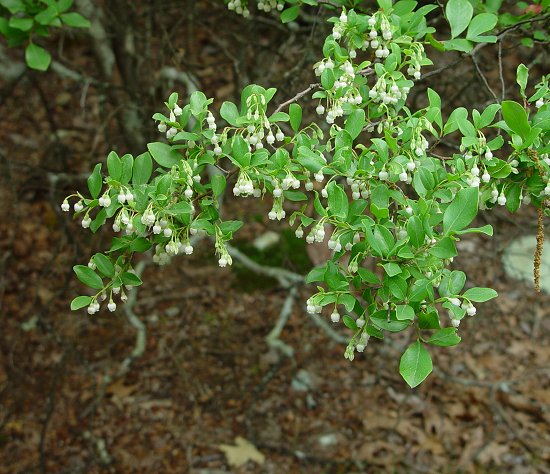Vaccinium arboreum Marshall
Farkleberry

Native
CC = 6
CW = 3
MOC = 42
© DETenaglia
Vaccinium arboreum MarshallFarkleberry | |
 |
Native CC = 6 CW = 3 MOC = 42 |
© DETenaglia |
|
Family - Ericaceae Habit - Medium to tall shrubs or small trees 2-5 m in height. Stems - Bark brown, longitudinally furrowed, peeling in thin plates with age. Twigs sparsely to densely hairy, green or reddish-tinged, becoming gray with age. Twigs pubescent, reddish. New season growth pubescent to velutinous.
Leaves - Alternate, simple, short-petiolate. Petioles to 1.5 mm long. Blades 20-55 mm long, 12-30 mm wide, thick and leathery, oblanceolate to broadly elliptic-obovate, the tip usually rounded or obtusely narrowed to a blunt point, the margins often with widely spaced, minute, glandular teeth; less commonly entire, otherwise glabrous or hairy, the upper surface glabrous, waxy and shiny, the undersurface dull, glabrous to sparsely hairy along the midvein.
Inflorescence - Terminal and axillary short racemes or solitary flowers. Flower stalks 4-10 mm long, with a conspicuous collarlike joint at the junction with the flower, often at least the lowermost stalks with small, leaflike bracts at the base. Axes pubescent.
Flowers - Calyx lobes 5, 0.7-1.0 mm long, the margins sparsely hairy toward the tip. Corollas 2.5-3.0 mm long, 3-4 mm in diameter, broadly urn-shaped to nearly bell-shaped, white, shallowly lobed, the 5 lobes reflexed. Stamens 10, not exserted, with 2 yellow spurs at the filament-anther junction, these slightly shorter than to about as long as the anther tubules, the filaments flattened, hairy along the margins, the anthers tapered to tubules 1.5-2.0 mm long. Styles 4-5 mm, slightly exserted.
Fruits - Berries 6-10 mm in diameter, black, shiny, not glaucous.
Flowering - May - June. Habitat - Upland forests, margins of glades, tops of bluffs, low woods along creeks or near swamps, on acidic substrates. Origin - Native to the U.S. Lookalikes - V. pallidum, V. stamineum. Other info. - This striking species occurs in Missouri mostly in the southeastern half of the state. Its larger range comprises a relatively sharply defined block within the southeastern quadrant of the continental U.S., with Missouri's populations lying near the northwestern edge of that block. The plant grows in acidic soils and doesn't transplant well, which is probably why it is not seen much in cultivation. The fruits of this species are edible but are tough and mealy, and generally considered unpalatable.
Photographs taken on Bell Mountain, MO., 6-1-03 (DETenaglia); also at Holly Ridge Conservation Area, Stoddard County, MO, 10-17-2017, and Gist Ranch Conservation Area, Texas County, MO, 6-9-2022 (SRTurner). |